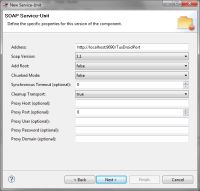Welcome to your first day starting guide!
Today, you will learn (or remind) what is a WSDL file, and how Petals ESB use it.
Lot of theory today. Don't worry, it's gonna be more and more practical everyday...
Any question, any problem? Find the solution on the WSDL and Administration discussion.
What is a WSDL?
The essential: understand what is a WSDL.
WSDL is essential to SOA. You will use WSDLs all over this guide.
Answer these questions before going any further.
- What does the "WSDL" acronym mean?
- What is a WSDL?
- What does a WSDL define?
- Why would you base communications on WSDLs?
- What differences are there between WSDL 1.1 and WSDL 2.0?
You can get answers here:
- [WSDL definitions].
- 5 minutes WSDL Tutorial.
- WSDL in 30 seconds.
- WSDL 2.0 vs 1.1.
- WSDL on Wikipedia.
I'm done! Give me the solution!
Find the differences!
Download those 5 sample WSDLs and look at them.
Can you find and explain the main differences between each?
Solutions:
Petals_Getting_Started_1.wsdl
Petals_Getting_Started_2.wsdl
Petals_Getting_Started_3.wsdl
Petals_Getting_Started_4.wsdl
Petals_Getting_Started_5.wsdl
Import a Web Service in Petals ESB, using Petals Studio
A web service is always described by a WSDL file.
Notice that other kinds of services can be described with a WSDL.
This exercice will introduce the manipulation of WSDL definition through Petals' tooling.
Follow these steps to import the 4 first WSDLs into Petals Studio.
Do not try with the 5th one. WSDL 2.0 support has been delayed from Petals.
- Download, Install and run Petals Studio: Petals Studio Download
- File > New > Service Unit Project. Window "Select the kind of service to create" is displayed.
- Select: Provide... / SOAP / the version of the SOAP component to use and click Next.
- Click Browse... and select your WSDL file. All the fields should be filled-in automatically. Click Next.

A Petals service is identified by the triplet (interface name, service name, endpoint name) defined in its jbi.xml file. If this service was associated with a WSDL, then the values in the jbi.xml must match those of the WSDL. - Define the name of the project and its location. Click Next.

In Eclipse, you cannot have two projects with the same name in a given workplace. - This current page expects properties that are specific to the Petals SOAP component.

This is the SOAP Component configuration page. Configuration is retrieved by Petals Studio: Soap version, Address... Stop you mouse on the fields for a description. Or read more on Petals-BC-SOAP documentation. - Click Next. You here come to the last page of this wizard. By default, you have nothing to do here.

This page defines CDK properties for the component. The CDK (Component development toolkit) is the basis of all the Petals components. Thus, these properties are common to several components. - Click Finish.
- Repeat for each WSDLs.
Look at the WSDL and jbi.xml files:
- In the left navigation tree, open any jbi.xml => Source Tab. Have a look and try to understand.

JBI standard (or JSR-208) defines the interactions between the container and components. jbi.xml files are used to configure artifacts in Petals. These artifacts can be components (if you develop a component), service-units (if you want to use a component), etc. So, basically, the jbi.xml file you opened is the file that configures the import of a Web Service in Petals (that makes it visible in Petals, to other Petals services). - Open the WSDL file => Source Tab. Those are the WSDLs you imported.
Let's package these Service-Units for Petals ESB!
Export Service-Units for Petals ESB:
- Click File > Export and select Petals > Service-Unit. Click Next.
- Check the project(s) "su-SOAP-XXX" to export. Select the output directory and click Finish.
DONE! Bravo!
Now you know (or you got reminded):
- What is a WSDL, its elements, the difference between WSDL 1.1 and 2.0.
- How to import a WSDL in Petals Studio and generate a configuration file for the Petals SOAP component (Petals-BC-SOAP).
- How to package Service-Units for Petals ESB.
Next step : Deploy, test, and monitor services in Petals ESB.
